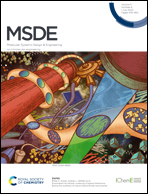Improving the Cd2+ detection capability of a new anionic rare earth metal–organic framework based on a [RE6(μ3-OH)8]10+ secondary building unit: an ion-exchange approach towards more efficient sensors†
Abstract
The synthesis and characterization of a new family of rare earth (RE) MOFs based on a hexanuclear (RE3+)6 secondary building unit (SBU) and the angular dicarboxylic ligand 4,4′-oxybisbenzoic acid (H2OBA) with the formula {((CH3)2NH2)2[RE6(μ3-OH)8(OBA)6]}∞ (((CH3)2NH2)2(1)(RE); RE: Y, Tb, Dy, Ho) is reported. Gas sorption studies indicated a moderate Langmuir area of 377 m2 g−1. Photoluminescence studies in the visible region of the ((CH3)2NH2)2(1)(Y) doped with 5% Eu3+ or 5% Tb3+ revealed the presence of the characteristic emission bands for these RE3+ ions. Cd2+ sensing studies of ((CH3)2NH2)2(1)(Y) doped with Eu3+ however, indicated slow exchange kinetics prohibiting the use of this material for sensing applications. Successful counter ion exchange of the as synthesized compound with Na+ and Mg2+ led to the isolation of Na2(1)(Y) and Mg(1)(Y). Interestingly, the exchanged analogue Na2(1)(Y) doped with 5% Eu3+ exhibited fast Cd2+ sorption kinetics and was proven to be a greatly improved sensor for this metal ion both in terms of kinetics and sensitivity. Batch Cd2+ sorption experiments at room temperature of Na2(1)(Y) revealed a maximum sorption capacity of 63 ± 2 mg g−1 corresponding to the insertion of ∼1.25 equivalents Cd2+ per (Y3+)6 SBU. Overall this work demonstrates the post-synthetic ion exchange of the bulky ((CH3)2NH2)+ counter-ions by inorganic cations as an excellent method for the improvement of the sensing capability of RE-based anionic MOFs.
![Graphical abstract: Improving the Cd2+ detection capability of a new anionic rare earth metal–organic framework based on a [RE6(μ3-OH)8]10+ secondary building unit: an ion-exchange approach towards more efficient sensors](/en/Image/Get?imageInfo.ImageType=GA&imageInfo.ImageIdentifier.ManuscriptID=C9ME00176J&imageInfo.ImageIdentifier.Year=2020)
- This article is part of the themed collection: Molecular systems for sensing


 Please wait while we load your content...
Please wait while we load your content...